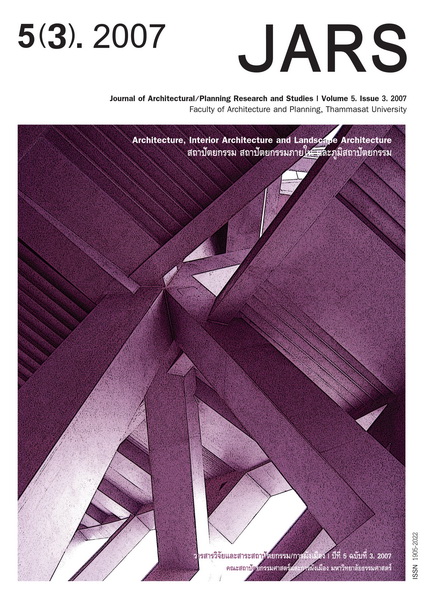Rudimentary Educational Survey on Acoustic Landscape of Lakefront Scenic Areas: A Case Study of Hangzhou City, China
Main Article Content
Abstract
Urban open spaces are important for improvement in urban living quality. Traditional research on
open spaces mainly focuses on spatial forms and visual esthetics to analyze environmental quality,
but lacks adequate consideration regarding acoustic elements. In the field of the acoustic environment,
people pay much attention to interior sound quality design and noise pollution. In order to provide a new
viewpoint for urban design and to reinforce design methods, herein, the concept of soundscape was
introduced. In this survey, the types and the features of lakefront soundscapes, as well as visitors’ spatial
distribution were observed. Thirteen pairs of sound and image scenarios were presented to 112 subjects at
a tourism city, Hangzhou, China. The sounds and images used were of real settings in lakefront scenic
areas. Affective response was measured in terms of pleasure. Through the evaluation on the influence of
the interaction between visual and acoustic stimuli on perception of the environment, it is proved that
there is a need to identify places where the conservation of the sound environment is essential, due to the
drastic impact of the loss of sound quality or its salient informational content on human appreciation,
especially in theme spaces, and folk-custom landscapes. Moreover, the coherence between sound and
image influences human preferences, since coherent combinations are rated higher than the mean of the
component stimuli. As a result, the spatial partition of soundscape is also necessary with the movement of
the visual images. Finally, some design guidelines regarding soundscape are proposed with the illustrations
of four typical lakefront spots.
Downloads
Article Details

This work is licensed under a Creative Commons Attribution-NonCommercial-NoDerivatives 4.0 International License.
All material is licensed under the terms of the Creative Commons Attribution 4.0 International (CC-BY-NC-ND 4.0) License, unless otherwise stated. As such, authors are free to share, copy, and redistribute the material in any medium or format. The authors must give appropriate credit, provide a link to the license, and indicate if changes were made. The authors may do so in any reasonable manner, but not in any way that suggests the licensor endorses you or your use. The authors may not use the material for commercial purposes. If the authors remix, transform, or build upon the material, they may not distribute the modified material, unless permission is obtained from JARS. Final, accepted versions of the paper may be posted on third party repositories, provided appropriate acknowledgement to the original source is clearly noted.
References
Durmisevic, S., & Sariyildiz, S. (2001). A systematic quality assessment of underground spaces-public transport stations. Cities 18(1), 13-23.
Southwork, M. (1969). The sonic environment of cities. Environment and Behavior, 1, 49–70.
Schafer, M. R. (1969). The new soundscape. Vienna, Austria: Universal Edition.
Truax, B. (1978). The handbook for acoustic ecology. Vancouver, Canada: A.R.C. Publications.
Schafer, M. R. (1977). The tuning of the world. New York: Knopf.
Skanberg, A., & Ohrstrom, E. (2002). Adverse health effects in relation to urban residential soundscapes. Journal of Sound and Vibration, 250(1), 151–155.
Augoyard, J. F. (1999). The cricket effect. In H. Karlsson (Ed.), From awareness to action-Proceeding of Stockholm, Hey Listen! conference on acoustic ecology (pp. 1-7). Stockholm, Sweden: The Royal Swedish Academy of Music.
Carles, J. L., Barrio, I. L., & Lucio, J. V. (1999). Sound influence on landscape values. Landscape and Urban Planning, 43, 191-200.
Schulte-Fortkamp, B. (2002). The meaning of annoyance in relation to the quality of acoustic environments. Noise and Health, 4, 13–28.
Raimbault, M., Lavandier, C., & Berengier, M. (2003). Sound ambient assessments of urban environments. Applied Acoustics, 64, 1241–1256.
Job, R. F. S. (2001). The impact of soundscape, enviroscape and psychscape on the reaction to noise: Implication for evaluation and regulation of noise effects. Noise Control Engineering Journal, 49(3), 120–124.
Viollon, S., Lavandier, C., & Drake, C. (2002). Influence of visual setting on sound ratings in an urban environment. Applied Acoustics, 63, 493–511.
Lercher, P., & Schulte-Fortkamp, B. (2003). The relevance of soundscape research to the assessment of noise annoyance at the community level. Proceedings of the 8th International Congress on Noise as a Public Health Problem, Rotterdam, The Netherlands, 225-231.
Stanners, D., & Bourdeau, P. (1995). Europe’s Environment: The Dobris Assessment. Copenhagen, Denmark: European Environment Agency.
Carles, J. L., Bernaaldez, F. G., & Lucio, J. V. (1992). Audio-visual interactions in soundscape preferences. Landscape Research, 17(2), 52-56.
Kaplan, R., & Herbert, R. J. (1987). Cultural and subcultural comparisons in preferences for natural settings. Landscape and Urban Planning, 14, 161-176.


